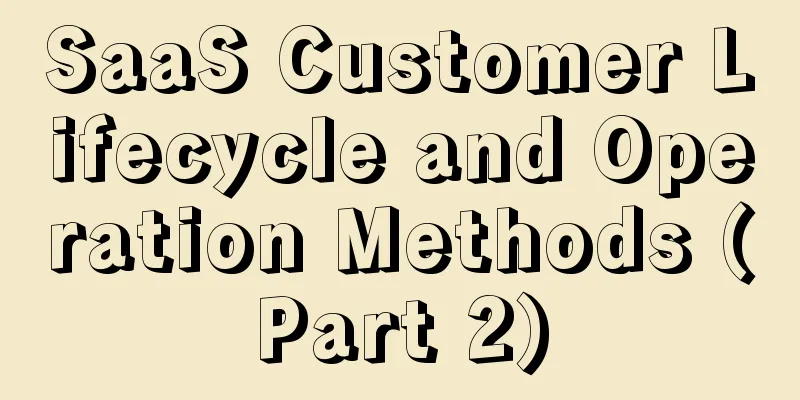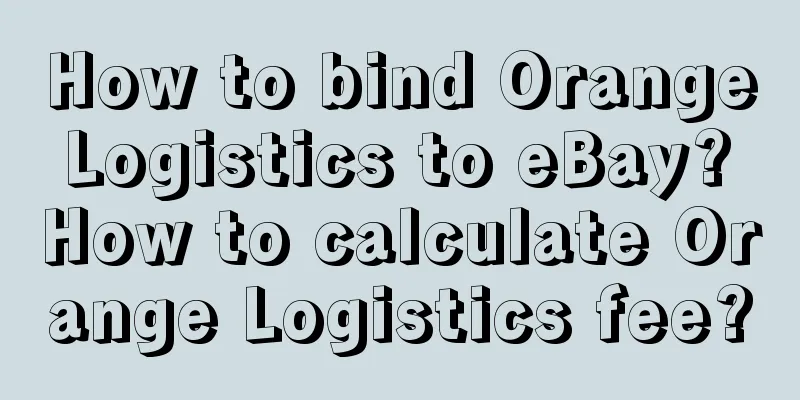SaaS Customer Lifecycle and Operation Methods (Part 2)

In SaaS Customer Lifecycle and Operation Methods (Part 1), we shared the content from user contact to user conversion. In this article, we will continue to share some operational work you should do after the user completes the transaction. After all, a large part of the SaaS business model is in the renewal stage. Here I will talk about some things about SaaS entrepreneurship. Many people regard SaaS entrepreneurship as a traditional business, such as: my advertising investment this time must have a positive ROI, my product must break even in the first year, etc. These ideal states may not be achieved until your third or fourth year. All you can do in the first year is to make your product well and achieve rapid commercialization. I will use an article another day to introduce SaaS entrepreneurship (the next one). The service begins when users purchase the product, and the use and service of the product determine whether the user will continue to use your product. Then a very important link that follows is: user activation. 1. User ActivationActivating your users depends on the ease of use of your product and the excellence of your service. The two are complementary. If the product is not easy to use, your users will spend more time on service. If the product is not continuously improved, as the number of users increases, users will spend more time on service. However, when it comes to service, companies generally limit more resources, such as not adding employees, not providing budget, etc. To be honest, we did not do a good job in after-sales service. We turned after-sales service into customer service. We answered users' questions and collected their suggestions. As for whether the users' problems were truly solved, whether the good suggestions put forward by users were implemented within the company, and whether the product functions were improved, we did not care about these things. As long as users did not clamor for a refund, then the users' problems were never urgent. Such a business will never be very successful, so you need to have methods and strategies to guide users to use the product and actively solve users' problems in the after-sales stage. In order to provide better after-sales service, I also read some related books and found that the contents in the books are all like this: they all look right, but they are not practical. After doing it for a while, I found that this is a very interesting thing. Some classic books are highly condensed theories, and the information density is a bit high. If you have relevant experience, you can use these contents to guide your work and effectively improve your path. I have summarized some of the things I do in my after-sales work into brief steps here, which may be of some help to you. 1. Guide users to useUsers do not use the product directly after purchasing it. This is mainly because domestic products are quite complicated and the turnover of company employees is high. Many people cannot understand the product in a short period of time, so SaaS software providers are needed to teach them step by step. What's more frightening is that after your step-by-step teaching, users still will not use such a product. If it is financial management software, users have already formed a habit, and this type of product is easy to use. On the contrary, products developed by technology-oriented software companies are really fatal. If the user cannot use the product in one try, then teach them multiple times until they can use it. In order to solve the problem of users taking up too much pre-sales resources, many companies have started a service model of free once and paid twice. I have to say, if you design the product simpler, will users need you to provide secondary training? Spend more time on optimizing user paths rather than creating inconvenience for users. 2. Regular user return visitsIn the first two months, users will encounter many problems when using the product, and there will also be some glitches. You need to proactively solve users' usage problems, such as asking users about their current usage progress and their demands every two weeks. The purpose is to allow users to truly use the product and use it in their business. These regular return visits can solve 80% of the problems encountered by users, so the remaining 20% will not be a big problem. If the user's problem cannot be solved in two months, then you should prepare for three months. As users use the product in their business, they will become more and more comfortable with it. In addition, SaaS products are highly exclusive. Once they are familiar with your product, they will be less likely to use other products. Of course, your products cannot be too bad. If there are products that can be used directly without any learning costs, then your products will be eliminated. Therefore, the usability of a product is the standard for users, and service can only be the icing on the cake. If you give users a lousy product, you still won’t be able to retain users even if you provide a lot of services. 3. Market data reportYour data reports must not be used to please the employees who use the software. The reports show the workload and work performance of the employees, which are what the leaders care about. Everyone overlooks one point, thinking that report customization is a very valuable thing, and the usage rate of reports is very low. Users can still create display reports by exporting data. Any product manager who has this idea will definitely not be able to make a good product. You have to think about one thing clearly: who is the report for? Most reports are designed to please the leadership. The leadership decides whether to use your product next year. It is not realistic to ask the leadership to piece together the reports and export data to create reports by themselves. What you can do is to present the report well to users and optimize the product if there is any demand. Even if the usage rate of this product is very low, it is still a very important job. 4. Operate by user groupAssuming that your users have officially used the product, if you still use the current service method to serve your users, your after-sales service system will definitely collapse, so you need to accurately stratify your users. Many friends are confused about user segmentation and don’t know how to segment them. Let me tell you a simple rule: segment users according to the amount they pay. Those who pay more are the sponsors, and those who pay less are ignored. For users who pay more, you can provide the same service model as in the first step, and for those who pay less, you can use batch services to help them achieve their own growth. After you group your users, you will find that user operations are actually a very interesting thing. At this point, your users have fully used your product. Ideally, they will renew their subscription next year. However, an ideal situation is always an ideal situation and it cannot become your business model. You will also encounter some unexpected problems. What you are looking forward to is user renewal. Here you need to pay attention to the previous user service model and some strategies for user renewal. 2. User RenewalIf users renew their product subscriptions when they expire, it can bring in better profits, so you should start taking action three months before users renew their subscriptions. I have seen many companies contact users one week before their renewal is due, only to find that users have already kicked you off and replaced them with a competitor's product. It takes 3 months to start contacting users and solve some problems that users may encounter, because 3 months is enough time for users to find a better product. During these three months, the service intensity is not the same as before, and we also need to actively solve users' problems. Anyway, the initiative of renewal is in the hands of the users. You can refer to the user activation strategy for the specific service method. 1. User recommendationsWe always want users to recommend our products to more loyal users. Many companies, like the C-end, have organized many activities, such as rebates, cash back, etc. It has to be said that SaaS companies spend most of their energy on these little tricks, which is worthless. If your products and services are not good, users will not recommend your products no matter how much money you give them. If your products are easy to use and your team's service is good, users will actively recommend your products to their friends. So, put more energy and time on user needs and user usage rather than these little tricks. User recommendations are initiated by users themselves and will not change based on your wishes. There is no need to do so. In this article, you first understand how to make your product well, and then match these operational strategies and means, instead of taking operational means as the main way to convert users and ignoring the most essential issues. The content of the user life cycle has been introduced. You can learn the strategies in these contents, but don’t rely on them completely. In the current situation where competition in the SaaS industry is becoming increasingly fierce, what you should do is to make good products and services. Remember: operational strategies can only add icing on the cake, not provide timely assistance. Author: Zhang Mu, Operations Officer Source: WeChat public account "Operation Officer Zhang Mu" (ID: coozhangmu) |
<<: Copywriting Appreciation: Feng Tingyu's Knees
>>: Pinduoduo, the "uncut" live broadcast room
Recommend
Can the "Shao Yuxuan" who start a new business return to the top?
Can the influencers who "left" with traf...
How to reduce the weight of short video editing and secondary creation?
Secondary creation can give new life to the origin...
What should a novice individual seller do on Amazon? Some experience sharing
As a new Amazon individual seller, you may face ma...
In the post-Li Jiaqi era, how can Taobao beauty products revive?
This article deeply analyzes how Taobao beauty bra...
Amazon opens two new delivery facilities in the US
Amazon has opened two new delivery stations in Con...
Stop calling customers and sending group messages on WeChat
Why is it that marketing services that cast a wide...
【Collection】21 writing tips from top copywriters
Are you still worried about not being able to writ...
What is the difference between Amazon local stores and cross-border stores?
To open a store on Amazon, you first need to choos...
What is a "sense of co-creation" brand? Be in awe of great thinkers and explorers (1)
We should start with the definition of brand to ex...
In 2023, who still "believes" in the anchor?
Tietou, a live streamer who became famous for expo...
Who is responsible for the Manner coffee incident?
There is a lot of discussion about the Manner Coff...
Can I modify the price after listing on Shopee? How to set up discounts?
As e-commerce platforms continue to grow, more and...
Meituan Live is expanding aggressively, upgrading its strategy to meet the challenge of Douyin's lifestyle services
Meituan has recently promoted more merchants to pa...
How can a novice do cross-border e-commerce? How can a novice get started with cross-border e-commerce?
The potential of cross-border e-commerce is huge, ...
How can I use the shein app in the country? Why can't I open it?
Shein is a popular fashion e-commerce platform, bu...









